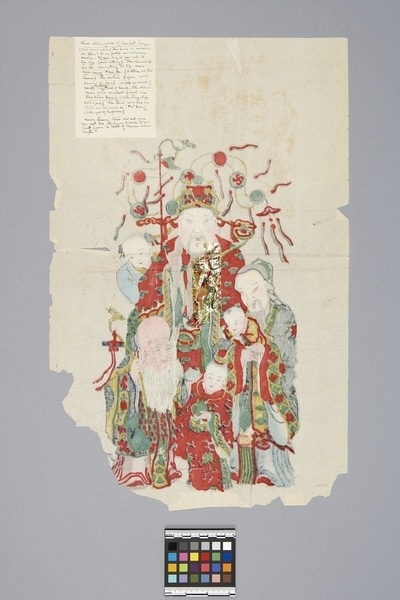Three Star Gods in the House Item Number: 1090/2 from the MOA: University of British Columbia


Description
Print depicting three gods known as the Sanxing or Three Star Gods (三星), Fu, Lu and Shou (Happiness, Fortune, and Longevity), with three children. Child at the front is holding a green pomegranate and is wearing clothing that has a green flower with blue leaves pattern on a red background while the other child is being held by the male figure standing to the left side. Faces are pink and white. The god Lu at the back and the god Fu at the left side both have red mouths with a long black moustache, a small black goatee, and a black beard in strands. The god Lu at the back is wearing clothing that has a green and blue cloud pattern on a red background. Behind him, there are various connected red, blue, and green ornaments with a writing, 三星在户. The god Fu at the left side is wearing clothing that has a red flower with green leaves pattern on a dark blue background. The god Shou at the front right side has a large forehead, a bald head, a red mouth, a long white moustache, a small white goatee, and a bushy white beard. He is holding a staff and is wearing yellow clothing that has a red, green, and blue trim. The child behind has her hair adorned with ornaments and is wearing light blue clothing. Background is simply the plain paper. The print is vertically rectangular.
History Of Use
Known as menshen (门神, door gods), they are considered to protect homes from evil spirits. Prints depicting them are usually displayed on the door inside and outside the house during the Chinese Spring Festival (春节) or Lunar New Year. Such prints are thus known as nianhua (年画, new year pictures).
Narrative
This set of prints (1090/1-13) was collected by Abbie Lyon Sharman, the sister of the donor’s grandmother, Sophia Lyon Fahs.
Cultural Context
Nianhua (年画, new year pictures) are usually printed on plain backgrounds, but some prints from Yangliuqing (杨柳青), known for the production of nianhua have background designs with patterns. The Yangliuqing style is known for finishing details, especially on the face.
Item History
- Made in Yangliuqing, Tianjin, China during 1920
- Collected during 1920
- Owned by Brenda Beck before December 20, 1985
- Received from Brenda Beck (Donor) on December 20, 1985
What
- Name
- Three Star Gods in the House
- Identification Number
- 1090/2
- Type of Item
- Overall
- height 55.5 cm, width 34.8 cm, depth 0.1 cm
Who
- Culture
- Chinese
- Previous Owner
- Brenda Beck
- Received from
- Brenda Beck (Donor)
Where
- Holding Institution
- MOA: University of British Columbia
- Made in
- Yangliuqing, Tianjin, China
When
- Creation Date
- during 1920
- Collection Date
- during 1920
- Ownership Date
- before December 20, 1985
- Acquisition Date
- on December 20, 1985
Other
- Item Classes
- works on paper
- Condition
- fair
- Accession Number
- 1090/0002